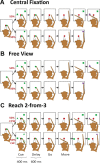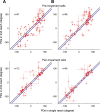Dorsal parietal area 5 encodes immediate reach in sequential arm movements
- PMID: 24005297
- PMCID: PMC6618382
- DOI: 10.1523/JNEUROSCI.1162-13.2013
Dorsal parietal area 5 encodes immediate reach in sequential arm movements
Abstract
To generate a coherent action sequence, it is essential to integrate all component movements beforehand, and such sequence-related information has been observed in numerous brain regions. However, this high-level sequential plan encompassing multiple motor elements in parallel ultimately must be decomposed into serial motor commands to be executed by the musculoskeletal system. In the present study, we recorded single-neuron activity from dorsal parietal area 5 (area 5d) while monkeys performed a double-reach task, and found that area 5d conveys the immediate upcoming reach, but not the subsequent movement, as opposed to the entire movement sequence being encoded as in other cortical sensorimotor areas. The elementary movement coded in area 5d suggests that unfolding of the motor sequence begins in the parietal-frontal cortex, instead of being exclusively implemented by downstream subcortical and spinal circuits.
Figures












Similar articles
-
Different representations of potential and selected motor plans by distinct parietal areas.J Neurosci. 2011 Dec 7;31(49):18130-6. doi: 10.1523/JNEUROSCI.6247-10.2011. J Neurosci. 2011. PMID: 22159124 Free PMC article.
-
Reaching movements with similar hand paths but different arm orientations. II. Activity of individual cells in dorsal premotor cortex and parietal area 5.J Neurophysiol. 1997 Nov;78(5):2413-26. doi: 10.1152/jn.1997.78.5.2413. J Neurophysiol. 1997. PMID: 9356393
-
Cortical mechanisms related to the direction of two-dimensional arm movements: relations in parietal area 5 and comparison with motor cortex.Exp Brain Res. 1983;51(2):247-60. doi: 10.1007/BF00237200. Exp Brain Res. 1983. PMID: 6617794
-
Cortical mechanisms subserving reaching.Ciba Found Symp. 1987;132:125-41. doi: 10.1002/9780470513545.ch8. Ciba Found Symp. 1987. PMID: 3322711 Review.
-
Parietal cortex: from sight to action.Curr Opin Neurobiol. 1997 Aug;7(4):562-7. doi: 10.1016/s0959-4388(97)80037-2. Curr Opin Neurobiol. 1997. PMID: 9287198 Review.
Cited by
-
Slow but flexible or fast but rigid? Discrete and continuous processes compared.Heliyon. 2024 Oct 18;10(20):e39129. doi: 10.1016/j.heliyon.2024.e39129. eCollection 2024 Oct 30. Heliyon. 2024. PMID: 39497980 Free PMC article.
-
Functional versus effector-specific organization of the human posterior parietal cortex: revisited.J Neurophysiol. 2016 Oct 1;116(4):1885-1899. doi: 10.1152/jn.00312.2014. Epub 2016 Jul 27. J Neurophysiol. 2016. PMID: 27466132 Free PMC article.
-
Overlapping representations for reach depth and direction in caudal superior parietal lobule of macaques.J Neurophysiol. 2015 Oct;114(4):2340-52. doi: 10.1152/jn.00486.2015. Epub 2015 Aug 12. J Neurophysiol. 2015. PMID: 26269557 Free PMC article.
-
Mixed Spatial and Movement Representations in the Primate Posterior Parietal Cortex.Front Neural Circuits. 2019 Mar 11;13:15. doi: 10.3389/fncir.2019.00015. eCollection 2019. Front Neural Circuits. 2019. PMID: 30914925 Free PMC article. Review.
-
Posterior parietal cortex predicts upcoming movement in dynamic sensorimotor control.Proc Natl Acad Sci U S A. 2022 Mar 29;119(13):e2118903119. doi: 10.1073/pnas.2118903119. Epub 2022 Mar 21. Proc Natl Acad Sci U S A. 2022. PMID: 35312363 Free PMC article.
References
-
- Ashe J, Taira M, Smyrnis N, Pellizzer G, Georgakopoulos T, Lurito JT, Georgopoulos AP. Motor cortical activity preceding a memorized movement trajectory with an orthogonal bend. Exp Brain Res. 1993;95:118–130. - PubMed
-
- Averbeck BB, Chafee MV, Crowe DA, Georgopoulos AP. Parietal representation of hand velocity in a copy task. J Neurophysiol. 2005;93:508–518. - PubMed
Publication types
MeSH terms
LinkOut - more resources
Full Text Sources
Other Literature Sources
